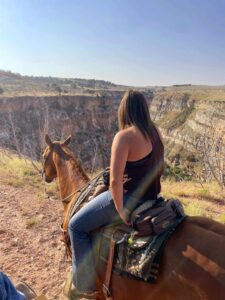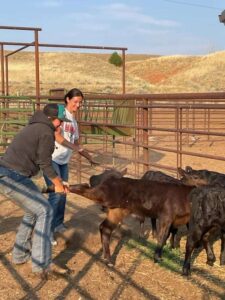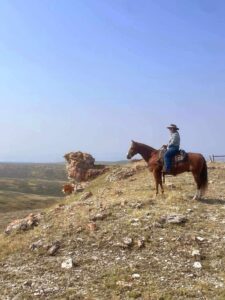Managing “Delphinium occidentale” (Tall Larkspur)
#bfrdpwy #aginternship #RightRisk
This week was a mix of checking calves, doctoring sick calves we found, and cutting down Tall Larkspur, scientific name Delphinium occidentale. We are preparing to move a set of cows to their next pasture on the mountain, so that means riding through the herd every couple of days to check for sick calves. The calves are susceptible to pneumonia and if not caught in time, will kill them. We vaccinated them against pneumonia when we branded and another time after branding; however, the vaccine only works for a few weeks then wears off. If a calf catches pneumonia, it can be hard to identify and can take their life quickly. Healthy calves are alert, move along when we ride close and they like to run around, while signs of a sick calf we look for are droopy ears, a dull like appearance and the sick calf won’t jump up and run when we ride close. It is important to catch sick calves as early as possible to prevent the disease from taking its life.

Once a sick calf is identified by one of us riding, we come together to rope it. When the calves are smaller or are very sick, one person can rope the heels of the calf and drag it forward which will cause the calf to lay down. Once it is down, the two other people come off their horses to grab the calf’s front leg and hold it down while medicine is administered in the neck. As it is later in the summer, the calves are big and very strong, so sometimes it takes one person to rope the neck and another person to rope the heels of the calf to hold it down. The remaining person will administer the medicine while the calf is secured by the ropes. These methods have been used for centuries and are used in daily cowboy life to this day.

Another important job for the cattleman is taking care of their pastures, which involves preventing and destroying poisonous plants such as Tall Larkspur. Larkspur is deadly to cattle if ingested, it will kill fully grown cows along with the calves. Many ranchers are able to use an herbicide to spray it every couple years to control the population, and my host used to be able to do this. He has an issue with Larkspur on one of his mountain allotments, which adds another element to the issue as he has to go through the Forest Service to manage this area. In the past, he was allowed to use a certain herbicide to spray Larkspur and keep it under control; however, about three years ago, regulations changed, and he was no longer allowed to use herbicide to control Larkspur on his mountain allotment. My host has noticed on other occasions that chopping the plant at the base can reduce the amount of regrowth the next year by about 50% which is what we are doing on the mountain allotment. We bring sharpened shovels and walk through the brush to look for the Larkspur and unfortunately, we have found a lot. There are lots of young Larkspur growing, as well as some mature plants, which all need to be removed to protect the cattle. It has taken a couple days to get a good start on it, and we will be continuing to go out and chop the Larkspur until we have covered the whole area.

A question I had about poisonous plants such as Larkspur, was if they affected wildlife the same as they do livestock. I got to talk to my host about this question as she is very knowledgeable about the rangelands and some of the processes of the government as she works for the NRCS. I wondered if the Forest Service would allow Larkspur to be sprayed again if it had detrimental effects on wildlife like it has on cattle. She informed me that Larkspur does not affect wildlife like it does cattle and she has seen elk eat the tops of Larkspur on multiple occasions. She also noted that she believes they will allow Larkspur to be sprayed again in the future because the BLM has accepted seven new herbicides to be used on their ranges. The Forest Service and BLM are both government agencies that regulate certain areas of state and public land, so their regulations are similar in some respects. I thought this conversation was very informative and made me wonder more about the different regulations for plants on the government land.
I plan to take the information I have acquired this week to investigate other regulations on the Forest for other plants and compare those to the regulations on Larkspur. I also look forward to continuing to check the cattle and help ensure the calves are healthy.
Submitted by: Ronnie Owens
Edits by: GrowinG Internship Team

